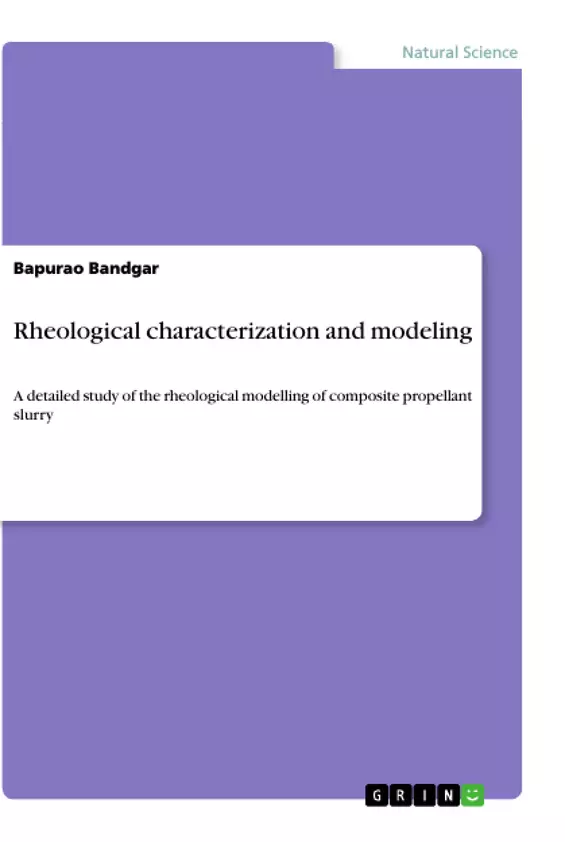A detailed study of the theological modelling of composite propellant slurry based on hydroxyl terminated polybutadiene (HTPB) prepolymer, Dioctyl adipate (DOA) plasticizer, toluene diisocynate curative, ammonium per chlorate (AP) oxidizer and aluminium powder as a metallic fuel is carried out and studied the effect of each of the ingredients on the composite propellant slurry (cps). The effect of temperature on viscosity of polymer and plasticizer system was studied at different temperatures, and torques (shear force). The polymer hydroxyl terminated polybutadiene (HTPB) and plasticizer (DOA) viscosity data showed temperature dependence and independent of the torque (i.e. shear force). Therefore, the viscosity data has been modelled to polynomial model of a fourth order with temperature for polymer and plasticizer.
The results showed good agreement between theory and experiment. These polynomial model results have been compared with Arrhenius model. The polynomial model showed better comparison within ± 4 % error compared to Arrhenius model with ± 4 to ± 22 % error over the temperature range of 30 - 70 °C. The viscosity of the mixture was also studied at different weight fractions of the polymer:plasticizer. The viscosity of mixture showed dependence on the weight fraction of the plasticizer and temperature.
Rheology concerns itself with the mechanism of flow and deformation of matter. Deformation is a phenomenon, which is associated with a volume element. This term was invented by Prof. Bingham of Lafayette College, Indiana. Significant advances have been made in polymer rheology, in bio-rheology and in suspension rheology. There has been a significant appreciation of the importance of rheology in the chemical processing industry like medicine, paints and printing ink technology etc. and biotechnological industries. It has also made important contributions in food technology, building and structural engineering, cosmetics, drilling operations and oil wells etc.
Inhaltsverzeichnis (Table of Contents)
- INTRODUCTION
- Fundamentals ofRheology
- Elements ofRheology
- The Flow Curve (Rheogram) and Viscosity Curves
- Basics ofPropellants
- Liquid Propellant
- Hybrid Propellant
- Solid Propellant
- Rheology of Composite Propellant Slurry and Earlier Reviews
- Scope ofthe Present Study
- References
- Materials used and Experimental Methods
- Raw Materials/Chemicals
- Equipment's used
- Brookfield Viscometer
- Rheomat RM 260 Photometer
- Rheological Measurement of Polymer, Plasticizer, Curatives and their Mixtures
- Rheological Measurement of Uncured Composite Propellant Slurry
- Rheological Measurement ofComposite Propellant Slurry
- Calculation of Percentage of Curative (TDI) required
- References
- Rheological Modelling of Polymers, Plasticizers and their Mixtures
- Data Interpretation and Theoretical Modelling
- Conclusions
- References
- Rheokinetic Modelling of Polymer, Plasticizer and Curative Systems
- Data Analysis and Modelling
- Temperature Modelling ofPolymer ( HTPB)
- Temperature Modelling for Polymer (HTPB) -Curative (TDI)
- Time Modelling ofPolymer (HTPB) -Curative (TDI) System
- Temperature Modelling for Polymer (HTPB)-Plasticizer (DOA) - Curative(TDI) System
- Temperature Modelling for Polymer (HTPB)-Plasticizer (DOA) - Curative(TDI) System
- Conclusions
- References
- Rheological Modelling and Characterization of Uncured Composite Solid Propellant Slurry
- Rheological Modelling and Characterization of Uncured Composite Solid Propellant Slurry
- Data Analysis and Modelling
- Conclusions
- References
- Rheological Modelling and Characterization of Cured Composite Solid Propellant Slurry
- Data Analysis and Modelling
- Conclusions
- References
Zielsetzung und Themenschwerpunkte (Objectives and Key Themes)
This work aims to contribute to the understanding of the rheological properties of composite solid propellant systems. It focuses on the development of mathematical models that can accurately predict the behavior of these systems under different conditions.
- Rheological characterization of various components of solid propellant formulations
- Modeling of the rheological behavior of uncured and cured propellant slurries
- Investigation of the influence of temperature and time on the rheological properties of the formulations
- Development of predictive models for the rheological behavior of composite solid propellants
- Understanding the relationships between the rheological properties and the performance characteristics of the propellants
Zusammenfassung der Kapitel (Chapter Summaries)
Chapter 1 provides a comprehensive overview of the fundamental concepts of rheology and the different types of propellants, particularly focusing on solid composite propellants. Chapter 2 delves into the materials and experimental methods employed in the study, including the detailed description of the equipment used for rheological measurements. Chapters 3 and 4 focus on the rheological modeling of the individual components of the propellant formulation, including polymers, plasticizers, and curatives. These chapters explore the application of various theoretical models to accurately predict the rheological behavior of these components. Chapter 5 delves into the rheological modeling and characterization of the uncured composite solid propellant slurry, analyzing the behavior of the mixture before curing. Finally, Chapter 6 examines the rheological properties of the cured composite solid propellant slurry, investigating the influence of curing on the rheological behavior.
Schlüsselwörter (Keywords)
This work explores the field of composite solid propellants, focusing on their rheological behavior and characterization. The study incorporates key concepts from rheology, material science, and chemical engineering, and delves into the impact of different parameters like temperature and time on the rheological properties of these systems. The study utilizes experimental techniques like Brookfield Viscometer and Rheomat RM 260 Photometer for measuring rheological properties of individual components and the composite propellant slurry. The research ultimately aims to develop predictive models that can accurately characterize the rheological behavior of these propellants under different conditions.
- Arbeit zitieren
- Dr Bapurao Bandgar (Autor:in), 2020, Rheological characterization and modeling, München, GRIN Verlag, https://www.grin.com/document/512892



